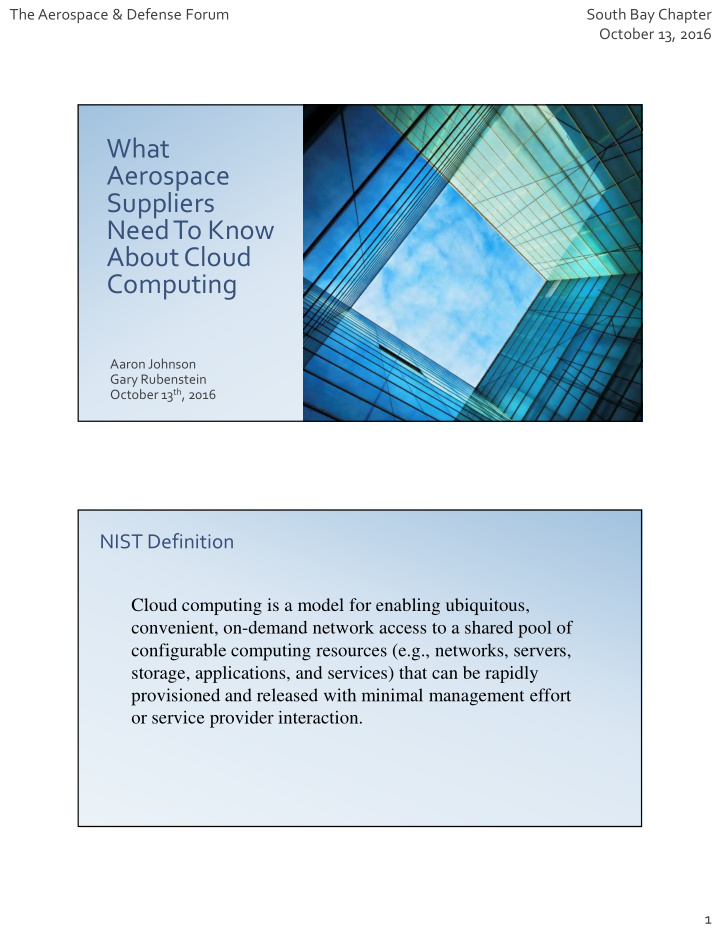



The Aerospace & Defense Forum South Bay Chapter October 13, 2016 What Aerospace Suppliers Need To Know About Cloud Computing Aaron Johnson Gary Rubenstein October 13 th , 2016 NIST Definition Cloud computing is a model for enabling ubiquitous, convenient, on-demand network access to a shared pool of configurable computing resources (e.g., networks, servers, storage, applications, and services) that can be rapidly provisioned and released with minimal management effort or service provider interaction. 1
The Aerospace & Defense Forum South Bay Chapter October 13, 2016 “Essential Characteristics” According to NIST • On-Demand Self-Service • Broadband Network Access • Resource Pooling • Rapid Elasticity • Measured Service Source: IRMS360 2
The Aerospace & Defense Forum South Bay Chapter October 13, 2016 Source: IRMS360 Types of Cloud Computing Service Models • Infrastructure as a Service (IaaS) – Storage, Memory, Real or Virtual Computers – Foundation of a Cloud Model • Platform as a Service (PaaS) – Adds Operating System and Development Tools – Speeds Time for Internal Application Development • Software As a Service (SaaS) – Fully usable application accessed via Cloud 3
The Aerospace & Defense Forum South Bay Chapter October 13, 2016 Deployment Models • On-Premise • Public • Private • Community • Hybrid On-Premises V. The Cloud WEB SERVICES & CONSIDERATIONS ON-PREMISE APPLICATIONS APPLICATIONS Location Location Infrastructure Infrastructure Business model Business model Ownership Ownership Management Management 4
The Aerospace & Defense Forum South Bay Chapter October 13, 2016 What is the “Cloud” Is It More than Software-as-a-Service (SaaS)? Cloud Shift Summary by Market Segment Source: Gartner Cloud Total Market Size Total Cloud Shift Cloud Shift Rate Legacy Segment Segment in 2016 in 2016 Through 2020 Business Process BPaaS $119 billion $42 billion 43% Outsourcing Application SaaS $144 billion $36 billion 37% Software Application Infrastructure PaaS $177 billion $11 billion 10% Software System IaaS $294 billion $22 billion 17% Infrastructure BPaaS is any type of horizontal or vertical business process that’s delivered based on the Cloud (e.g., ADP, Skype, YouTube, MailChimp, RedZone) SaaS is a software licensing and delivery model in which software is licensed on a subscription basis and is centrally hosted (e.g., NetSuite ERP, Concur, Salesforce CRM, Demand Solutions) PaaS is a category of cloud computing services that provides a platform allowing customers to develop, run, and manage applications without the complexity of building and maintaining the infrastructure typically associated with developing and launching an app. (e.g., Saleforce, Red Hat, QlikView) IaaS = infrastructure as a service (e.g., Amazon Web Services (AWS), Microsoft Azure, Rackspace) Technology Trends 5
The Aerospace & Defense Forum South Bay Chapter October 13, 2016 Cloud Justification Source: 451 Research Aerospace and Defense & the Cloud • Greater Collaboration at Lower Costs • A&D Requirements Driving Security Models • Improving Communication Between Quality and Production • Reducing Tooling Costs Using The Cloud • Higher Priority on Virtualized Applications at DoD • Evolution of CIOs in Traditionally Conservative Sector Source: Louis Columbus, in “Forbes” 6
The Aerospace & Defense Forum South Bay Chapter October 13, 2016 Key Considerations • Existing Infrastructure and Staff • Security and Compliance Needs • Cap Ex v. Op Ex • Type of Application Involved • Disaster Recovery • Service Level Agreements / Rebates (GRC) Source: Louis Columbus, in “Forbes” Compliance Standards Have Become More Important 7
The Aerospace & Defense Forum South Bay Chapter October 13, 2016 SaaS vs. On-Premise Reasons to Consider a Saas Solution • Lower Cost of Entry • Faster Deployment • Pay as You Go • Vendor is Responsible for Upgrades, Uptime and Security • Higher Adoption Rates • Integration and Scalability • Work Anywhere • Little or No Infrastructure • Reliable Performance SaaS vs. On-Premise Reasons NOT to Consider a Saas Solution • Regulatory / Legislative Issues • Geopolitical • Security Vulnerabilities • Highly Tailored Application • Hardware Dependent Solution • Legacy Integration • Control over your Servers • Cost of the Cloud • If it Ain’t Broke Don’t Fix it ~ Think Hybrid ~ 8
The Aerospace & Defense Forum South Bay Chapter October 13, 2016 SaaS vs. On-Premise Four-Year - 100 Users -TCO Distribution “Cloud computing is often far more secure than traditional computing, because companies like Google and Amazon can attract and retain cyber-security personnel of a higher quality than many governmental agencies.” Vivek Kundra, former federal CIO of the United States “There was a time when every household, town, farm or village had its own water well. Today, shared public utilities give us access to clean water by simply turning on the tap; cloud computing works in a similar fashion. Just like water from the tap in your kitchen, cloud computing services can be turned on or off quickly as needed. Like at the water company, there is a team of dedicated professionals making sure the service provided is safe, secure and available on a 24/7 basis. When the tap isn’t on, not only are you saving water, but you aren’t paying for resources you don’t currently need.” 9
The Aerospace & Defense Forum South Bay Chapter October 13, 2016 “If you don’t like change, you’re going to like irrelevance even less.” — General Eric Shinseki 10
Recommend
More recommend